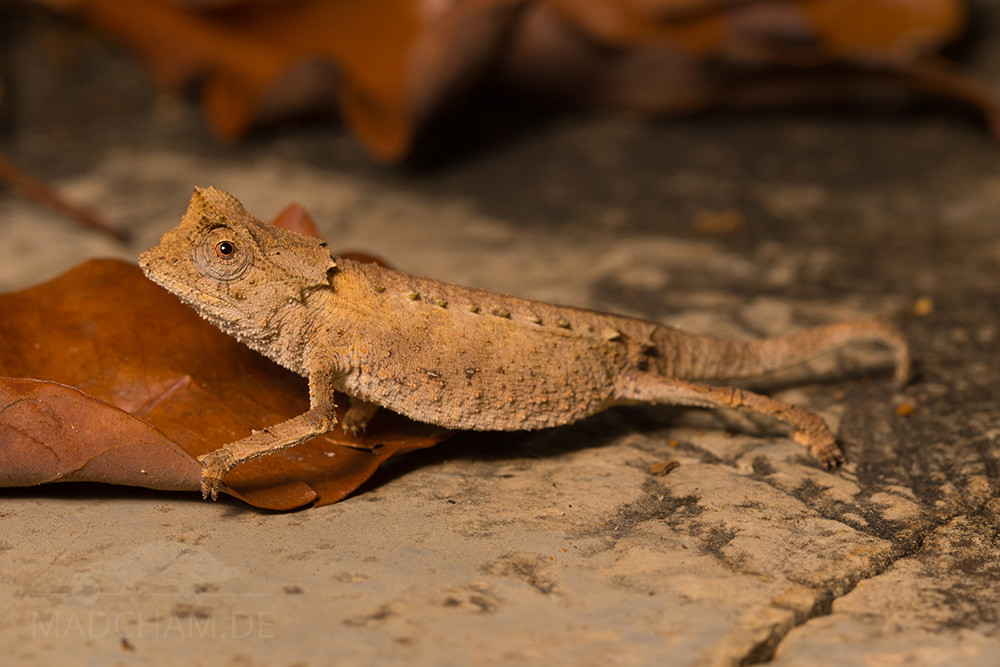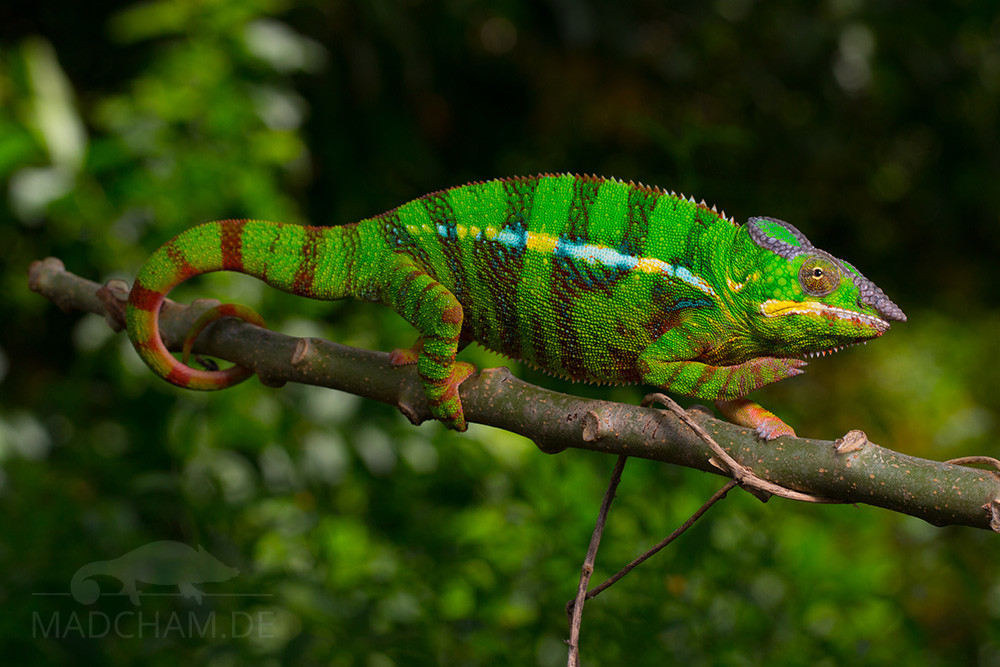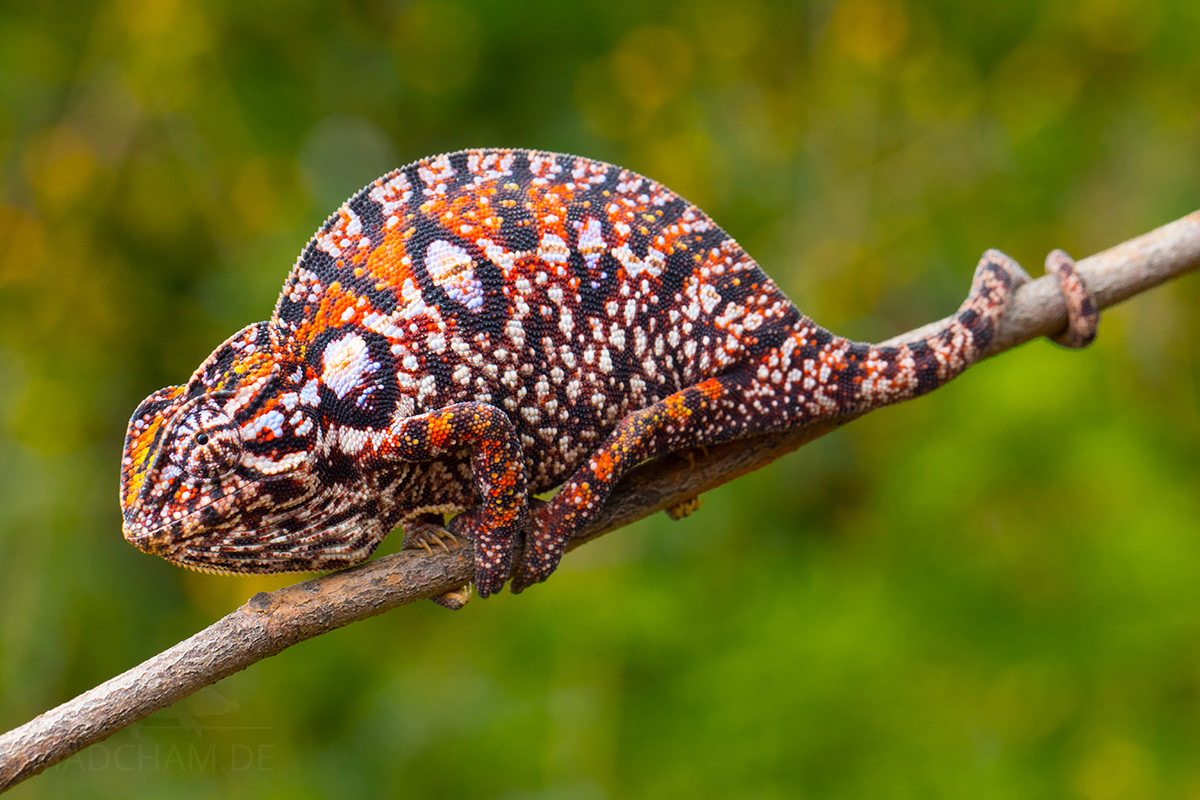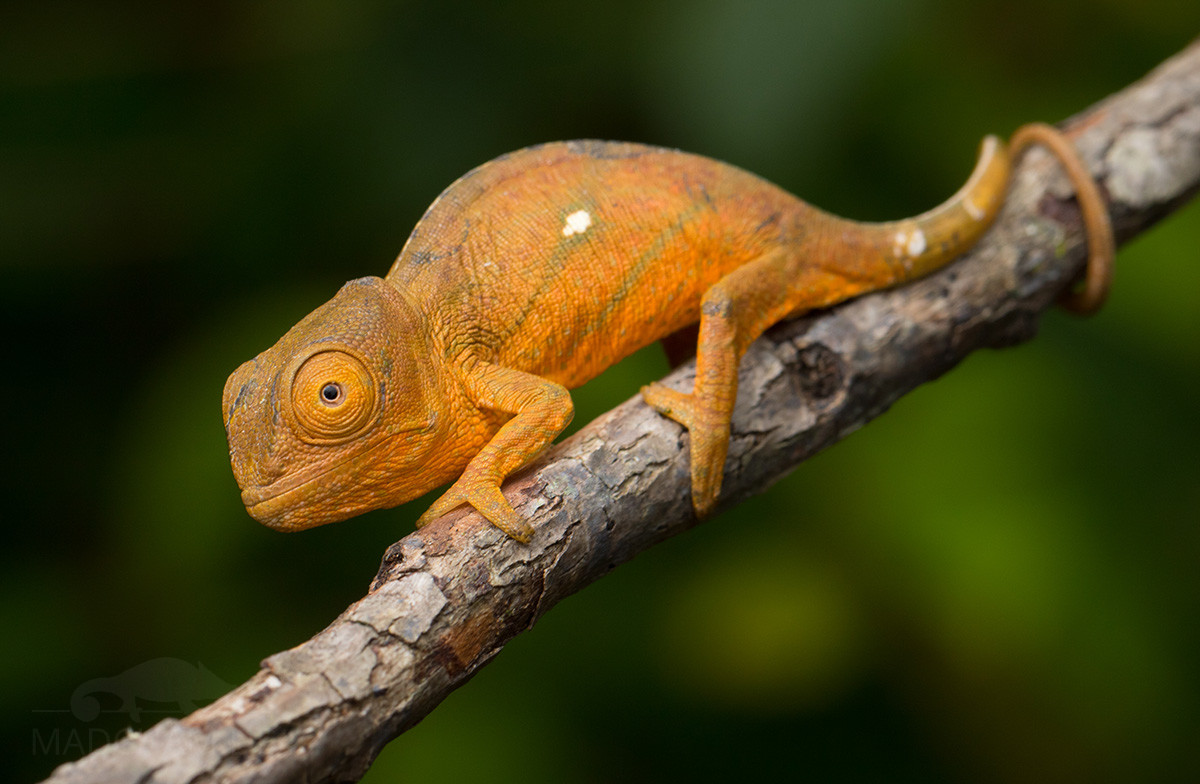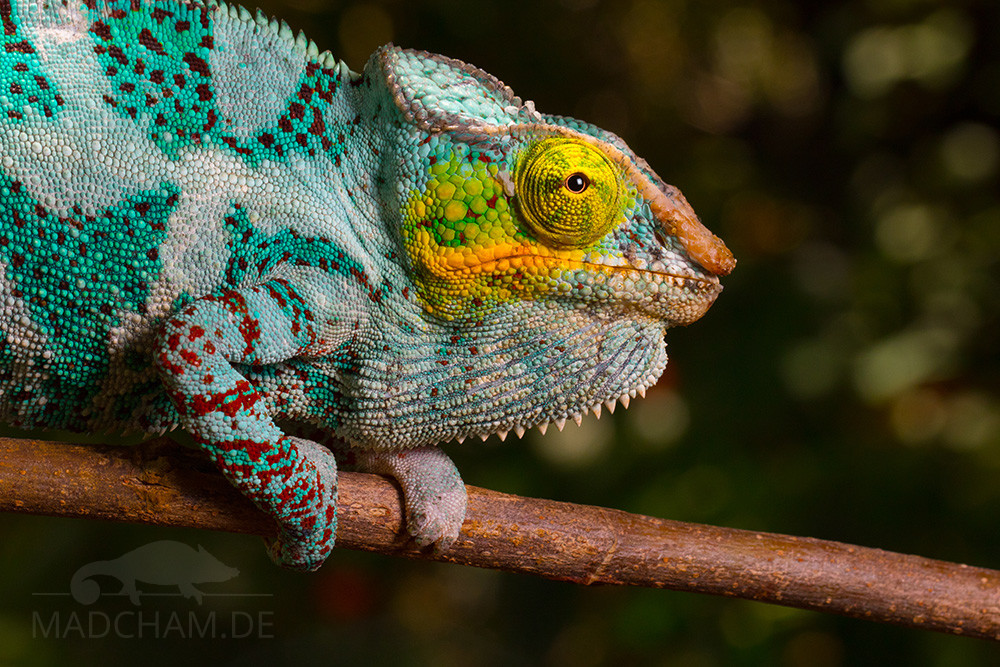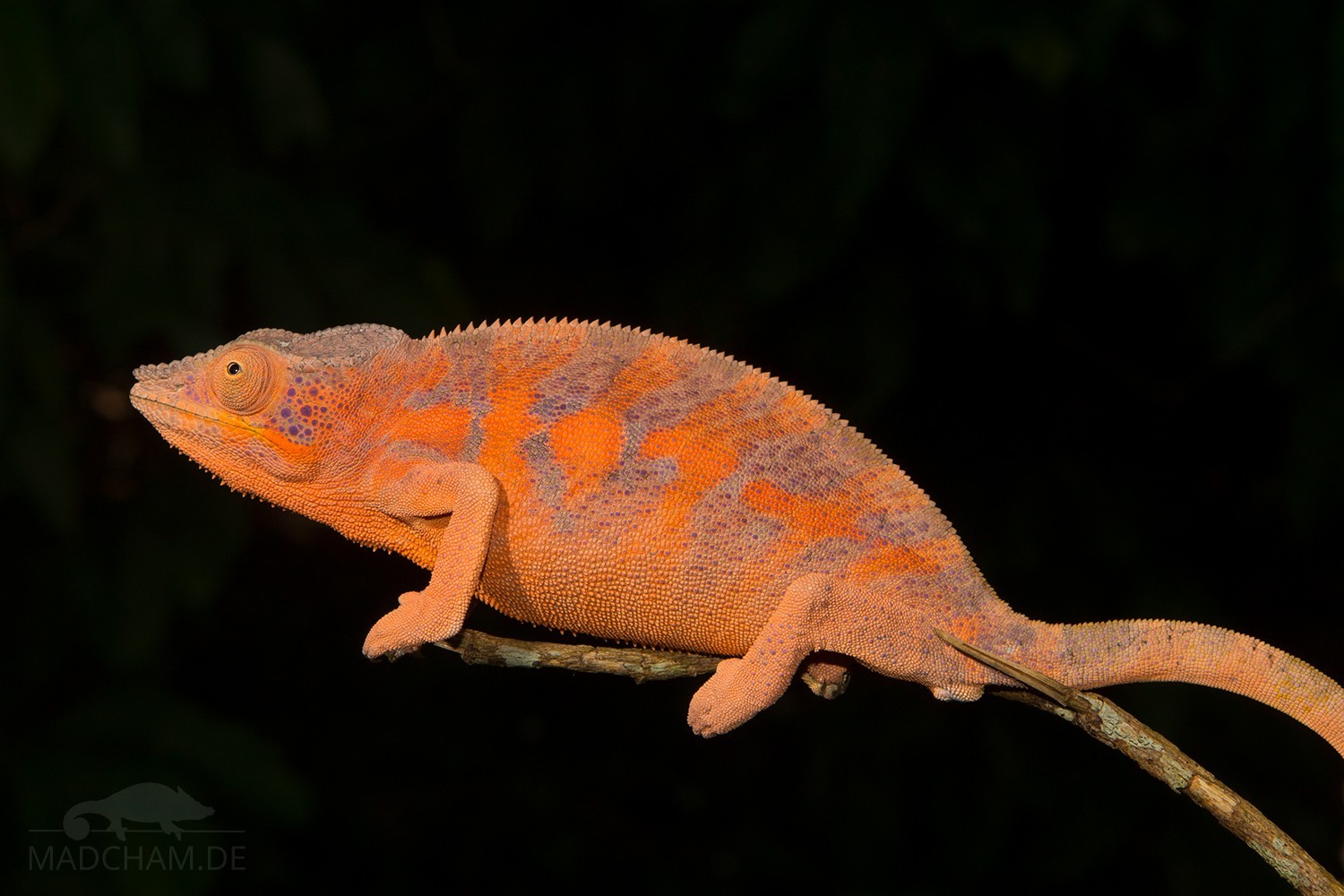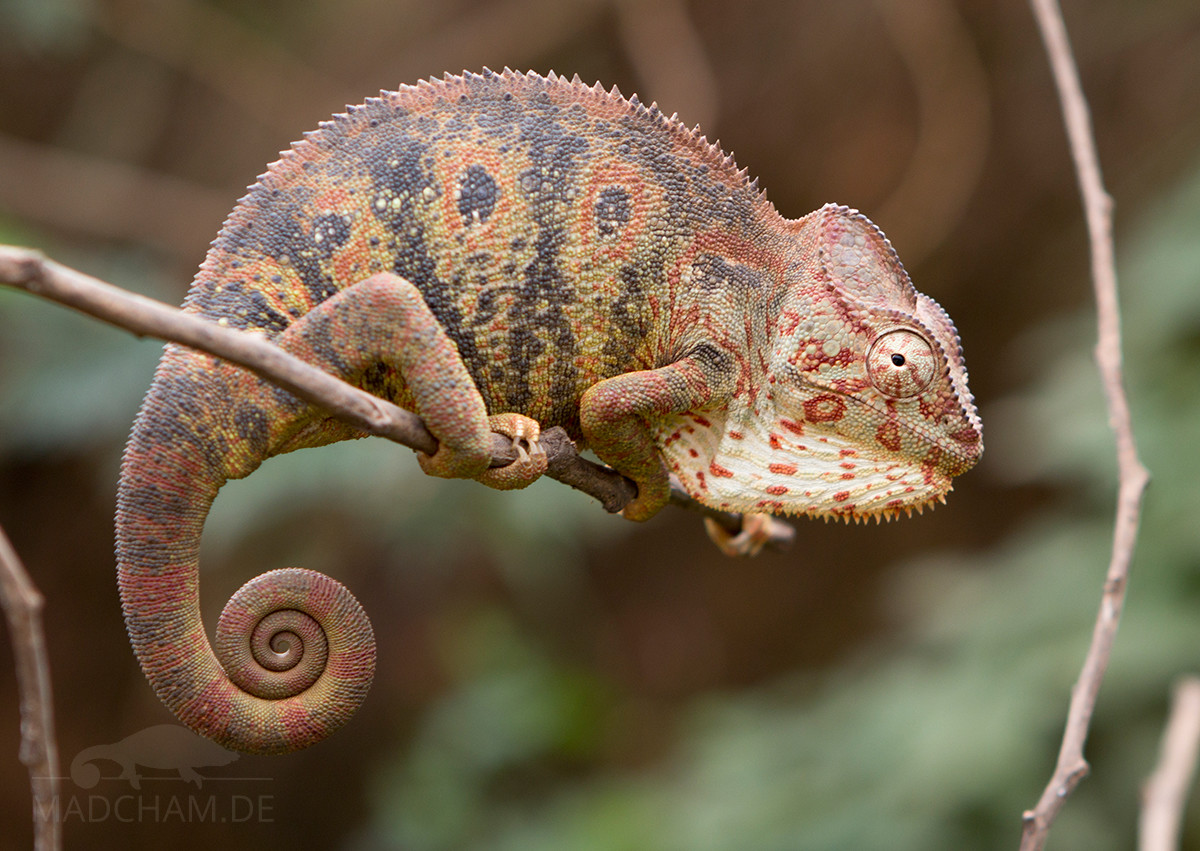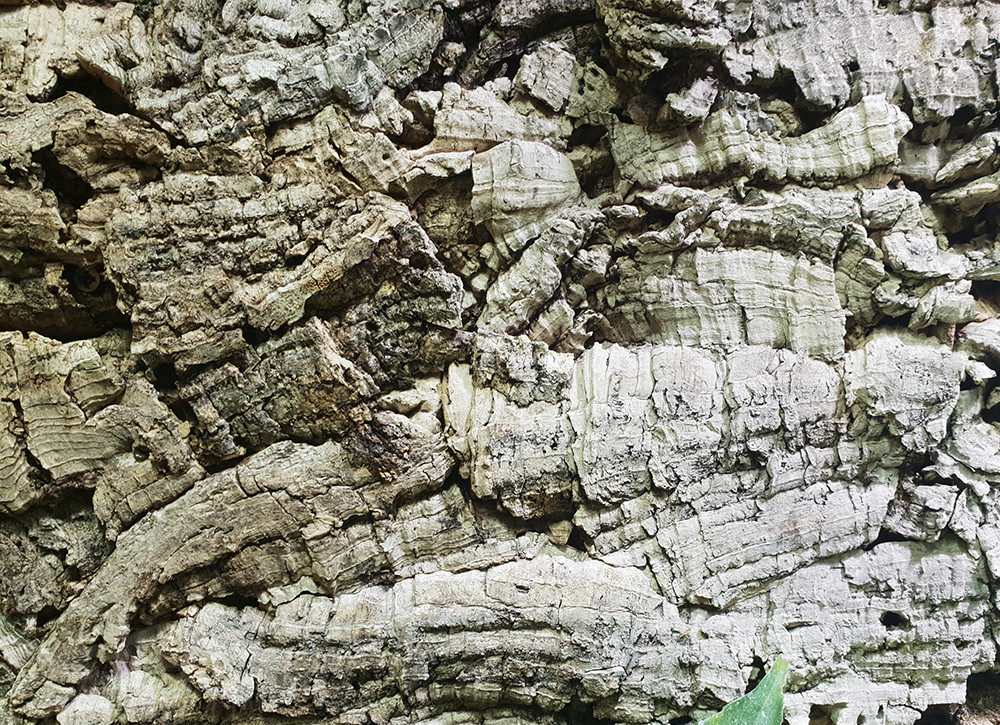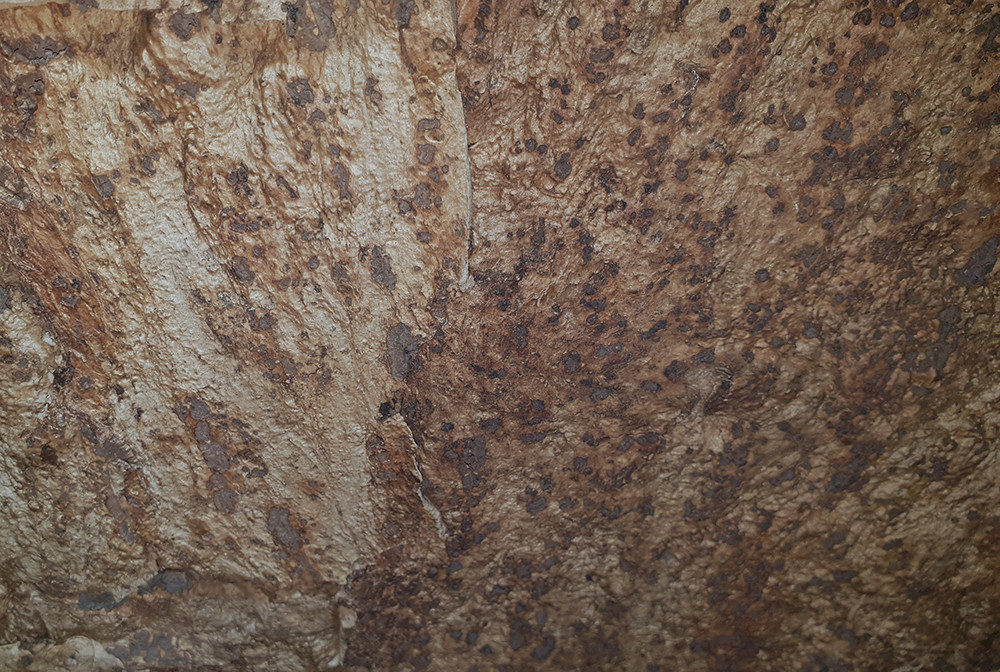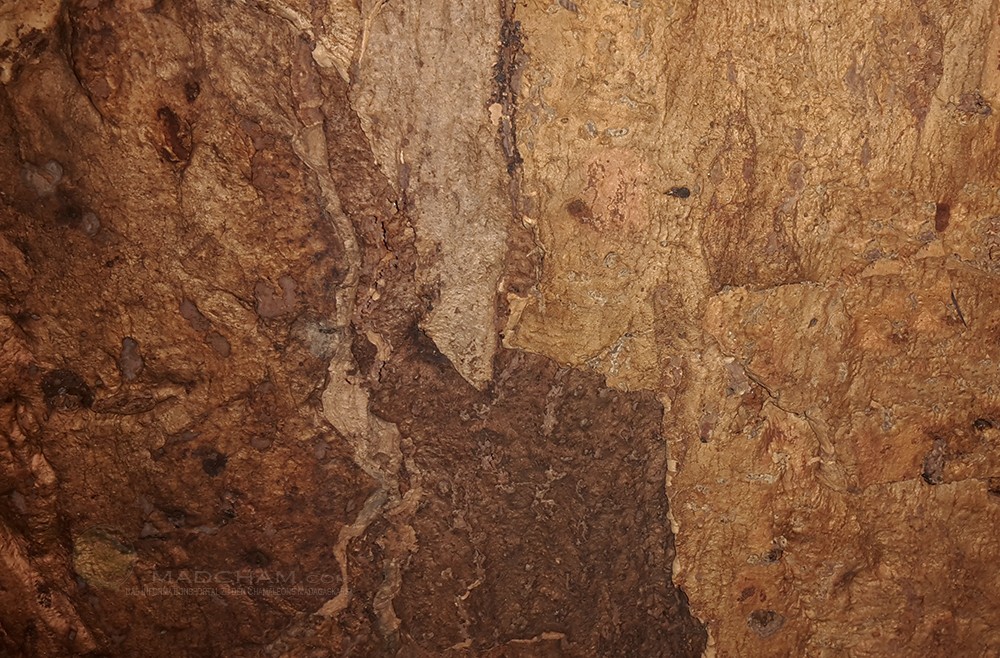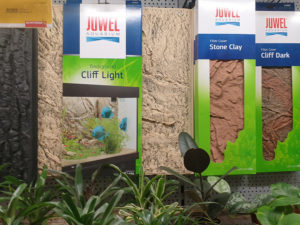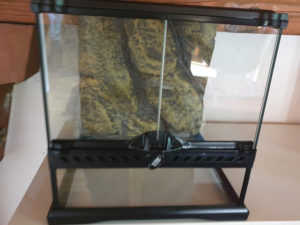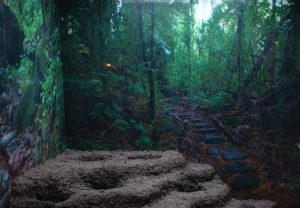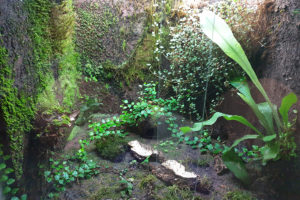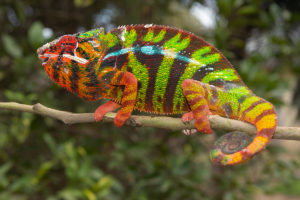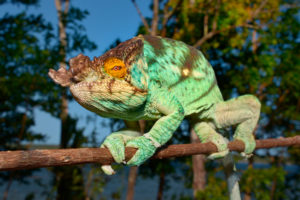Design of back walls in the terrarium
Most terrariums have plain back walls when they are built or bought – “back wall” here means all sides of a terrarium that do not consist of ventilation or glass for better visibility. No matter if the tank is made of glass, wood, OSB, screen printing plates, or Forex: All these common materials are initially not usable for a chameleon. It can hardly or not at all hold on to them. So they only serve as a limitation but have no other use for the animal. In addition, naked walls are usually not very attractive – OSB or a white hard foam board does not look like a rainforest or dry forest.
The following article is intended to shed light on the various options for back wall design, provide tips, and point out the advantages and disadvantages.
Inhaltsverzeichnis
Back walls with a climbable surface
In order to increase the usable area of the terrarium for a chameleon, it makes sense to provide the solid walls of the terrarium with a designed and not only a naked back wall. Back walls can have an insulating effect, but with chameleon terrariums, the insulating effect is rather negligible because of the large ventilation areas. With all rough, i.e. climbable surfaces, the disadvantage, unfortunately, remains that they are very difficult or impossible to disinfect in case of parasite infestation. This should be considered well in advance if you want to install a back wall. It may also be possible to attach the back wall in a way that it can be removed at a later date.
Cork panels
Cork panels are a very common way of designing a back wall in a chameleon terrarium. You can distinguish the somewhat more expensive decorative cork from the cheaper compressed cork.
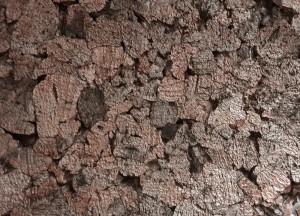
Pressed cork from very large cork pieces
Pressed cork panels are visually somewhat unattractive, but can be climbed by most chameleons because of their claws and the soft structure of the cork. They consist of granulated cork residues (e.g. old wine corks), which are mechanically pressed into coherent panels using glue. Since pressed cork with a thickness of two to five millimeters is often used as footfall sound insulation under laminate, it can be purchased by the roll. This has the advantage that the panels are relatively cheap (5-10 € per m²) and you can easily cut the size required for the terrarium with a cutter knife. Because of the small thickness of the panels, you can easily glue this kind of cork to the walls of the terrarium with silicone. For wall and roof insulation as well as for pinboards, pressed cork panels are available as ready-made cuts in all possible thicknesses. The prices per square meter vary accordingly.
Decorative cork panels, also known as cork bark tiles, consist of pressed cork boards about two millimeters thick, on which the flat-rolled bark of the cork oak (Quercus suber) has been glued. Due to the coherent bark look of the surface, decorative cork is much more beautiful than pressed cork, but also much more cost-intensive (from 80-100 € per m²). Decorative cork panels are usually available in pet shops or on the Internet with maximum sizes of 90 x 60 cm². For smaller chameleon terrariums, they can easily be cut to size with a jigsaw. For larger terrariums, you have to use several plates next to each other to cover the whole back wall. Ornamental cork panels should be covered with silicone or a construction adhesive and should be pressed very well and for a long time. They often become wavy after a long time, especially when using large panels. To prevent this, you can also screw the cork bark panels to the back of the terrarium if necessary.
Garden Screening
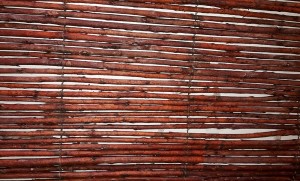
Willow screening
A simple solution for terrarium back walls are screens made of plant material from the hardware store. There is a relatively large selection, including reed and willow screening. The screenings are usually 1.80 m to 2.00 m high and rolled up several meters wide so that they can be cut to fit the terrarium and several terrariums can be equipped at the same time. Depending on the material you use, you should consider that you can still see the original back wall of the terrarium through the screening. Furthermore, you have to think about how to attach the screening. Willow screenings, for example, can only be glued or screwed together over a limited area, so that many small holes are left. Feeders like to escape behind them and might get difficult to get out again.
Caution, not all materials are suitable for chameleons! Bamboo mats, for example, are quite smooth and offer little grip. A further disadvantage of the garden screenings is that they are usually integrated into a wire mesh. Protruding wire ends have to be cut off/flattened with the side cutter and covered with silicone or other protection for use in chameleon terrariums.
Do it yourself (Styrofoam constructions)
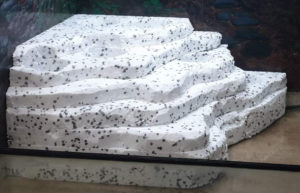
Several polystyrene plates glued to each other, with troughs for plants, before applying epoxy resin
If you like to tinker, you can design your own back walls at a very reasonable price. With Styrofoam or Styrodur as substructure, there are almost no limits to your imagination. You can get the plates for a few dollars in the hardware store. With a hot air dryer, saw, cutter knife, and patience you can bring the material into any shape you like. Once you have found the desired shape, you can coat the styrofoam several times with epoxy resin and/or tile adhesive, which you can tint with tinting paint or spray on later. This gives the polystyrene a waterproof and scratch-resistant surface. If you prefer to roughen the surface for a more natural look, you can also sprinkle sand, peat, or other materials on a layer of wood glue.
The big disadvantage of these back walls is the enormous amount of time they take and that construction is quite a mess. Beautiful backgrounds take several days to complete, and those who work full-time may need weeks to finish a wall. In addition, you should really practice a little with the material – most first tries don’t look as nice as you might have imagined. But if you show a skillful hand with the design and choice of colors, you can make really nice backgrounds yourself.
Clay plaster
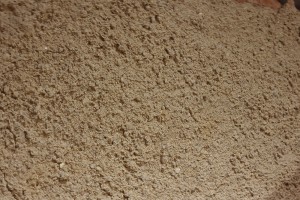
Clay back wall in the terrarium
Loam is a mixture of sand, silt, and clay and one of the oldest building materials in the world. As a clay plaster, it is especially suitable as a back wall in dry terrariums. If water is allowed to run over it, the uppermost layers liquefy and the loam is gradually removed further and further. Since all Malagasy chameleons need a rainy season, you should consider carefully in advance whether clay is the right material for the desired terrarium back wall.
Basically, clay plaster stores humidity and releases it very slowly back into the terrarium, so that a pleasant climate is created. For terrariums, there are already ready-made clay mixtures for back walls (e.g. TerraClay Saleg) which only need to be mixed with a given amount of water. Alternatively, you can also buy clay plaster for interiors yourself and mix it accordingly. Since clay does not stick to smooth walls, there are so-called plaster carriers in specialized shops, which you first stick on the back wall of the terrarium. The mixed, moist clay is then plastered over it. Be careful, the clay shrinks a little when drying! If there are any gaps, they must be filled again – unless you find them particularly decorative. In addition, loam forms a relatively heavy back wall. The basic material of the terrarium must be able to withstand this weight.
Commercial back wall modules
Several manufacturers of aquaristic and terraristic equipment (e.g. Back to Nature, ExoTerra, Juwel Aquarium, Lucky Reptile) now offer ready-made back wall parts in modular design. They mostly consist of coated polystyrene similar to the self-constructions mentioned above or glass fiber reinforced other plastic. The finished modules are only available in certain sizes so that for larger terrariums you have to use several modules next to each other. Compared to other design options for terrarium backgrounds, the finished modules are expensive but easy to install. You simply glue them into the terrarium with food-safe silicone and if necessary cut unsuitable modules with the cutter knife (if the manufacturer has provided for cutting, there are also non-cut versions available). The modules usually have predetermined channels on the backside, where you can hide cables. Since with chameleon terrariums the entire technology should be located outside the tank itself, the latter – for chameleons – is less important.
Bark
Small pieces of bark from deciduous trees can be glued together with aquarium silicone to form visually attractive backgrounds for terrariums. You should make sure that the pieces are as flat as possible, because strongly curved, larger pieces offer a later very annoying refuge for feeder insects. Dry bark is particularly suitable – the wetter and older the pieces are, the more likely they are to decompose slowly and then fall off the terrarium wall.
The best thing about this back wall design for the terrarium: Bark is usually free! The easiest way is to ask around in neighboring or allotment gardens who have just felled a tree and have to give bark away. Bark can also be collected in the forest, but strictly speaking, it belongs to the owner of the forest. In most of the states (not all of them!), one is allowed to take small amounts for personal use, thus a few handfuls, just like that. It is more skillful to briefly ask the responsible forester. When trees are felled and stored directly along forest roads, larger quantities of bark usually fall off. If you gently ask the responsible foresters, they usually have nothing against you making use of these places in small quantities.
Clinker brick slips
Clinker or split tiles are decorative, narrow elements with a stone look that are normally used for cladding house facades. They are usually intended to simulate brickwork, which is not present behind it. For terrariums, clinker brick slips made of wood, plastic, or styrofoam are the only ones that can be used. Real bricks are much too heavy for average terrarium back walls. In addition, plastic blinker brick slips are quite inexpensive. Clinker bricks made of styrofoam are sometimes gnawed at by insects – you should be aware of this risk. Clinker brick slips are usually attached with a special glue, but you can also use food-safe silicone in most cases. With the help of so-called joint crosses, small plastic parts, even narrow joints can be applied symmetrically without problems.
Back walls without climbable surface
In particularly spacious terrariums, the design of the back wall can be neglected sometimes. A great advantage of naked back walls is that the surfaces are easier to disinfect. With chameleons, however, this always has the disadvantage that the animals cannot use the smooth walls.
Decorative foil
Adhesive foil for the back of the terrarium can be bought very cheaply with somewhat kitschy motifs in pet shops. It is much more expensive, but also much nicer if you have your own motifs printed on adhesive foil in the appropriate size. The foil should be UV-resistant and waterproof, otherwise, you won’t enjoy it for long. Visually, printed adhesive foil is certainly an eye-catcher, after all, in the best case you can get the chameleon’s habitat into your terrarium.
Less recommended back panels
Coconut fiber mats or nets
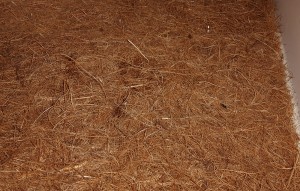
Coconut fiber mat
Coconut fiber is obtained from the outer shell of unripe coconuts. They are robust, can absorb moisture, and have little tendency to mold. In pet shops, there are special pre-formed panels with plant troughs, which are completely covered with coconut fiber, for terrarium back walls. Also “climbing nets” made of wire and coconut fibers are offered. However, back walls made of coconut fibers are only suitable for chameleons to a limited extent. There are a few (unpublished) cases in which chameleons have injured themselves with accidentally ingested coconut fibers on the eye and when swallowed in the intestine and require veterinary treatment.
Xaxim
Xaxim is often used in frog terrariums. It is used in the form of finished panels or as loose material for sprinkling and consists of dried parts of tree ferns as well as innumerable seeds of tropical mosses and small plants contained therein. Xaxim is partly extracted directly from rainforests in South America, which is not particularly beneficial to the protection of species and nature; in recent years it has increasingly come from specially established plantations in New Zealand. Concerning the costs, Xaxim plays in the upper league (80-200 € per square meter). Xaxim panels can easily be attached to the back walls of the terrarium with silicone.
However, the biggest advantage of Xaxim is unfortunately also the biggest disadvantage for chameleons: With very intensive irrigation Xaxim starts to green and flower after a few weeks to months. More precisely Xaxim must actually always be dripping wet to actually form a kind of “living back wall”. Spraying once or twice a day is not enough. But exactly this permanent wetness is not desired in chameleon terrariums – see also the article about ventilation. Therefore many chameleon owners who wanted to use Xaxim in their terrariums have been disappointed. Xaxim usually does not grow in species-appropriate chameleon terrariums or only very sparsely.
White peat panels
White peat is organic sediment, which in principle consists of incompletely decomposed, rotting plant remains. It forms the uppermost layer of a bog, only about one millimeter of which is added every year. White peat has a very low pH value, i.e. it is acidic and therefore not suitable for all plants.
Similar to Xaxim, white peat panels are “self greening” under very wet conditions and are often used in frog terrariums. White peat is hardly suitable for chameleons for the same reasons as Xaxim. As bogs and swamps are home to the most highly endangered fauna and flora and grow only extremely slowly, the extraction of peat for garden or terrarium purposes and the associated drainage of moors has also come under heavy public criticism in recent years.
Moss or plant panels
For some years now, moss pictures and whole moss walls have been in fashion for interior design. These are dried moss, which is preserved with paint and preservatives to make it durable and attractive. The “pictures” are very expensive because of the high production costs and individual sizes, but look nice and natural. You can glue them into the terrarium with aquarium silicone. It is unclear whether the preservation of the moss, which is almost nowhere indicated by the manufacturers, could be harmful to chameleons if swallowed by accident. Real, still living moss, on the other hand, must be kept constantly moist to keep it alive. It is therefore not suitable for chameleon terrariums as back wall vegetation, nor is Xaxim or white peat.
Artificial turf, artificial plants
In addition to the classic artificial turf, the pet trade now offers plastic grids, which are equipped with plastic plants and are intended to serve as back wall designs in terrariums. One may argue about the optics. However, the fake “plants” do not offer any climatic advantages and are also not edible. They are therefore a danger for the chameleon if swallowed accidentally. Plastic plants or parts of them are among the foreign bodies that veterinarians have to operate from reptiles again and again. Therefore they do not belong as a back wall in the terrarium.

